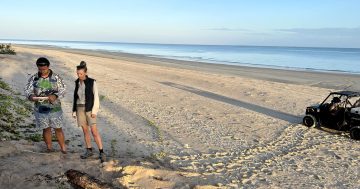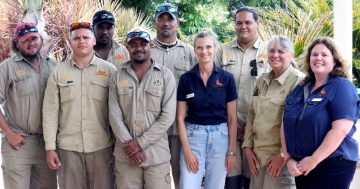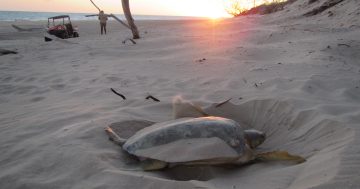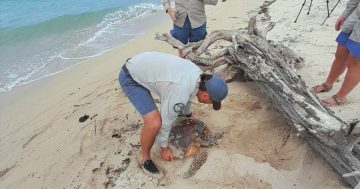
Shade cloth placed over these nest protection cages has shown promising results for olive ridley sea turtles. Photo: Cape York NRM.
The trial of a “simple and effective” method involving shade cloth has shown to have high promise in securing the future of sea turtles on Cape York.
Initial research showed rising temperatures were resulting in more female hatchlings than male hatchlings, which was particularly detrimental for an already endangered species like the olive ridley sea turtle.
The Cape York Natural Resource Management’s Western Cape Turtle Threat Abatement Alliance (WCTTAA) conducted a study on Pennefather Beach on the western Cape York Peninsula last year, placing shade cloth over selected nest protection cages to determine its efficacy.
WCTTAA coordinator Dr Manuela Fischer reported the shaded nests had a maximum temperature difference of more than six degrees when compared to a control site with no shade.
“This is an encouraging result,” Dr Fischer said.
“It means we can now conduct a more long-term and comprehensive study across several beaches to record the effects of using shade to protect these nests from rising sand temperatures, and the impacts this has on hatchlings.”
The trial involved five turtle nests that were fitted with temperature loggers.
The loggers collected temperature data points every half hour for two months on the nests with shade cloth and nests without as a control.
“On average, the temperature in the nest was 1.82 degrees cooler in the shaded area, and the maximum difference we found was 6.58 degrees,” Dr Fischer explained.
“This was great news, as the method of shading was simple and effective.”
Dr Fischer explained that the incubation temperature at which a one-to-one male-to-female sex ratio is produced was known to be about 30 degrees.
Temperatures higher than that produced more female hatchlings, while temperatures lower produced male hatchlings.
“A concern is that sex ratios will become increasingly female-biased,” she said.
“It is possible that low numbers of males in the turtle population will reduce the fertilisation capacity and the loss of the genetic variation, which therefore may lower the chance to adapt to environmental changes.”
She announced earlier this year that WCTTAA had secured funding from the Australian Government’s Marine Turtle Climate Change Resilience and Nest Protection grant, which would support the research until March 2025.
“With this money, we have been able to buy the necessary equipment to shade the nests and record the temperatures,” Dr Fischer said.
“Ultimately, the research will determine what impact climate change has on sea turtles and predict hatchling sex ratio, so we can implement appropriate management actions, such as lowering the temperature in the nests.”
Following the success of the 2023 trial, this year’s research will use 42 temperature loggers across at least three different beaches.
These loggers will be able to collect data every 30 minutes for approximately one year.
“It’s going to be a busy season this year, and I can’t wait to see what we discover,” Dr Fischer said.

Hotter sand temperatures are leading to more female hatchlings and threatening the future of the species. Photo: Cape York NRM.







